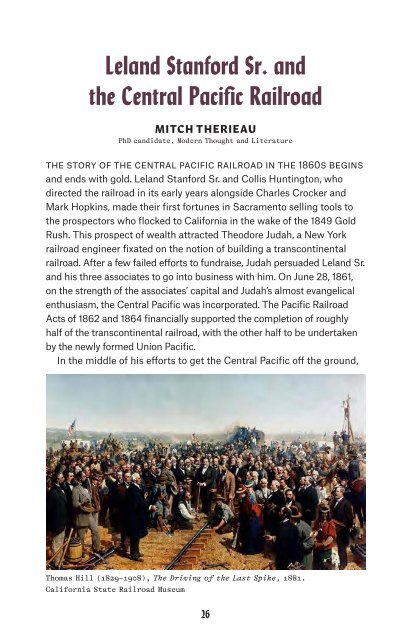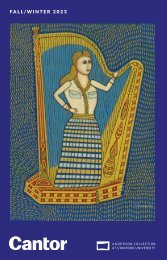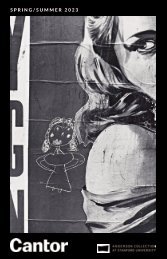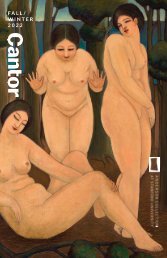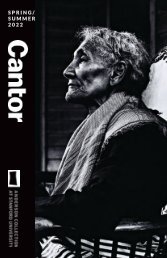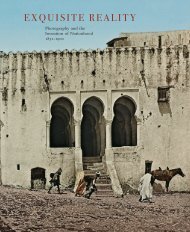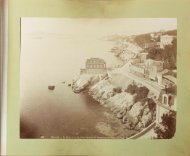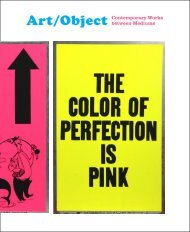Gallery Guide | The Melancholy Museum
Using over 700 items from the Stanford Family Collections, artist Mark Dion’s exhibition "The Melancholy Museum" explores how Leland Stanford Jr.’s death at age 15 led to the creation of a museum, university, and—by extension—the entire Silicon Valley.
Using over 700 items from the Stanford Family Collections, artist Mark Dion’s exhibition "The Melancholy Museum" explores how Leland Stanford Jr.’s death at age 15 led to the creation of a museum, university, and—by extension—the entire Silicon Valley.
Create successful ePaper yourself
Turn your PDF publications into a flip-book with our unique Google optimized e-Paper software.
Leland Stanford Sr. and<br />
the Central Pacific Railroad<br />
MITCH THERIEAU<br />
PhD candidate, Modern Thought and Literature<br />
THE STORY OF THE CENTRAL PACIFIC RAILROAD IN THE 1860S BEGINS<br />
and ends with gold. Leland Stanford Sr. and Collis Huntington, who<br />
directed the railroad in its early years alongside Charles Crocker and<br />
Mark Hopkins, made their first fortunes in Sacramento selling tools to<br />
the prospectors who flocked to California in the wake of the 1849 Gold<br />
Rush. This prospect of wealth attracted <strong>The</strong>odore Judah, a New York<br />
railroad engineer fixated on the notion of building a transcontinental<br />
railroad. After a few failed efforts to fundraise, Judah persuaded Leland Sr.<br />
and his three associates to go into business with him. On June 28, 1861,<br />
on the strength of the associates’ capital and Judah’s almost evangelical<br />
enthusiasm, the Central Pacific was incorporated. <strong>The</strong> Pacific Railroad<br />
Acts of 1862 and 1864 financially supported the completion of roughly<br />
half of the transcontinental railroad, with the other half to be undertaken<br />
by the newly formed Union Pacific.<br />
In the middle of his efforts to get the Central Pacific off the ground,<br />
Thomas Hill (1829–1908), <strong>The</strong> Driving of the Last Spike, 1881.<br />
California State Railroad <strong>Museum</strong><br />
26<br />
Alfred A. Hart (1816-1906), <strong>The</strong> Last Rail Is Laid. Scene at Promontory<br />
Point, May 10, 1869, 1869. Stanford University Archives<br />
Leland Sr. was elected governor of California. A known railroad<br />
proponent, he rarely missed an opportunity to mention the benefits that<br />
long-distance rail travel would bring to the state. Even in his inaugural<br />
address, he emphasized that a transcontinental railroad would make<br />
it easier for California to trade with Nevada, where significant gold<br />
and silver deposits had been discovered. Of course, given his business<br />
arrangements, such a railroad would bring significant monetary gain<br />
to Leland Sr., too. Still, this mixing of the railroad, personal profit, and<br />
political interests cut both ways, as he used his authority as governor<br />
to raise funds for the Central Pacific. Gold helped foment the desire<br />
that gave birth to the Central Pacific, and gold had a hand in shaping<br />
its route across the West; thus, it was only appropriate that gold would<br />
commemorate its completion.<br />
On May 10, 1869, near Promontory, Utah, after more than six years<br />
of brutal exploitation and unfathomable misery on the part of Chinese<br />
migrant workers in particular, the Central Pacific and the Union Pacific<br />
were joined with a Golden Spike. Fittingly, it was Leland Sr. who gently<br />
tapped this spike into a tie made of California laurel. <strong>The</strong>n the Golden<br />
Spike was quickly un-driven, and an undocumented railroad worker<br />
drove in the iron spike that would supposedly serve as the real final link<br />
between East and West. <strong>The</strong> Golden Spike became part of the room of<br />
Stanford memorabilia installed in 1893, the year of Leland Sr.’s death,<br />
reminding visitors of the origins of the wealth that built this university.<br />
27


